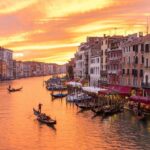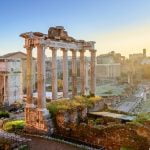Embark on a journey through time with “A Traveller’s History of Italy,” as we delve into the rich and captivating story of this enchanting country. From the ancient ruins of Rome to the artistic legacy of the Renaissance, Italy’s history is a tapestry woven with tales of conquest, cultural splendor, and culinary delights. Whether you are a history enthusiast or an avid traveler, join us in uncovering the timeless allure of Italy’s past.
Italy’s history is as diverse as it is fascinating, and our exploration begins with a captivating look at Ancient Rome. As we wander through the cobblestone streets of the Eternal City, we will uncover the remnants of an empire that once spanned across continents. From there, our journey will lead us to unravel the artistic and cultural legacy of the Renaissance, shedding light on Italy’s contributions to art, literature, and innovation.
But our adventure does not stop there. We will also take a deep dive into the historical landmarks that dot Italy’s landscape, tracing the rise and fall of the Roman Empire and witnessing firsthand how these remnants continue to shape modern Italy. Additionally, we’ll explore how Italy’s unification has paved the way for its unique national identity and delve into the sumptuous world of Italian cuisine.
Join us on this mesmerizing expedition through “A Traveller’s History of Italy,” where we will marvel at Italy’s stunning landscapes-from the snow-capped Alps to the sun-kissed shores of the Mediterranean-and come to understand how tradition seamlessly intertwines with innovation in modern-day Italy. Through our journey, we hope to inspire a deeper appreciation for this timeless land steeped in history.
Ancient Rome
When exploring ancient Rome, one cannot miss the opportunity to visit the Roman Forum, which was once the political, commercial, and religious center of the city. Here, visitors can wander through the ruins of ancient temples, basilicas, and government buildings while imagining what life was like during this pivotal period in history.
For those interested in delving deeper into ancient Roman history, a visit to the Palatine Hill is a must. This legendary hill is where Romulus is said to have founded Rome, and it later became home to some of the most powerful emperors in Roman history. The site offers breathtaking views of both ancient and modern Rome and provides insight into the evolution of this influential civilization.
- Must-visit sites in Ancient Rome:
- Colosseum
- Pantheon
- Roman Forum
- Palatine Hill
By immersing oneself in ancient Rome’s rich history and architectural splendor, one can gain a deeper appreciation for Italy’s enduring legacy as a cradle of civilization. Whether strolling through cobblestone streets or gazing upon majestic ruins, travellers are sure to be captivated by the timeless allure of this remarkable city.
The Renaissance
One of the most significant aspects of the Italian Renaissance was its impact on artistic innovation. The period saw a renewed interest in classical Greek and Roman ideals, leading to a revival in literature, philosophy, and visual arts.
Artists such as Botticelli, Raphael, and Titian produced timeless works that reflected a newfound appreciation for beauty and humanism. The construction of architectural marvels like Florence’s Duomo and St. Peter’s Basilica in Rome also represented a shift towards grandeur and opulence.
In addition to its artistic achievements, the Italian Renaissance was also a time of immense cultural change. The era witnessed advancements in science, technology, and exploration that transformed society.
Italy became a hub for intellectual exchange as scholars and thinkers from across Europe flocked to cities like Florence and Venice to engage in lively discourse. The invention of the printing press by Johannes Gutenberg further fueled the dissemination of knowledge across borders, laying the groundwork for future developments in communication and education.
| Italian Renaissance | Significant Aspects |
|---|---|
| Artistic Innovation | Renaissance saw renewed interest in classical Greek and Roman ideals |
| Cultural Change | Advancements in science, technology, and exploration transformed society |
The Roman Empire
Italy is a country steeped in history, with remnants of the Roman Empire still visible today. A traveller’s history of Italy would not be complete without exploring the historical landmarks that demonstrate the grandeur and influence of this ancient civilization. From the iconic Colosseum in Rome to the well-preserved ruins of Pompeii, there are countless sites that offer a glimpse into the power and sophistication of the Roman Empire.
One cannot help but feel dwarfed by the imposing structures that have withstood centuries of wear and tear, serving as a powerful reminder of the empire’s dominance. The Forum Romanum, once the heart of ancient Rome, continues to attract visitors who marvel at its grandeur and imagine what life was like during this period. The Pantheon, with its architectural brilliance and engineering marvels, stands as a testament to Roman ingenuity and innovation.
Travellers can also explore lesser-known but equally impressive sites such as Hadrian’s Villa in Tivoli or Ostia Antica, an ancient port city that offers a fascinating glimpse into daily life during Roman times. Each site presents an opportunity to delve deeper into the complexities and achievements of one of history’s most influential empires. Through these historical landmarks, travellers can truly appreciate the lasting impact of the Roman Empire on Italy and the world.
Italy’s Unification
Pre-Unification Italy: Fragmented States and Foreign Rule
Before the unification, Italy was made up of numerous small states, kingdoms, and territories, each with its own ruler and administration. Additionally, foreign powers such as Austria, France, and Spain held significant influence over different parts of the Italian peninsula. This fragmentation created a complex geopolitical landscape that hindered the formation of a cohesive Italian identity.
Risorgimento: The Movement for Unification
The Risorgimento movement emerged as a response to the longing for a unified Italian nation. Intellectuals, revolutionaries, and nationalists from across Italy played pivotal roles in advocating for independence from foreign rule and the establishment of a unified Italian state. The movement was fueled by ideals of patriotism, liberty, and national pride, leading to widespread uprisings and revolutions against foreign dominance.
Unification Achieved: The Birth of Modern Italy
After years of political maneuvering, diplomatic negotiations, and armed conflicts, Italy finally achieved unification in 1861 under King Victor Emmanuel II. The process involved significant contributions from influential figures such as Giuseppe Garibaldi and Count Camillo di Cavour.
As a result of this historic achievement, Italy embarked on a new chapter in its history as a unified nation with Rome as its capital. Understanding this pivotal period sheds light on the complexities of governance at that time and its impact on shaping modern Italy’s cultural, social, and political landscape.
Italian Cuisine
Italy’s culinary history is as rich and diverse as its cultural and artistic heritage. From the northern regions of Lombardy and Piedmont to the southern coasts of Sicily and Calabria, Italian cuisine is a reflection of the country’s varied landscapes and traditions. Each region boasts its own unique flavors, ingredients, and cooking techniques, making Italy a paradise for food enthusiasts and a traveler’s history of Italy.
One cannot explore the history of Italian cuisine without delving into the origins of pasta, which has become a staple in kitchens all over the world. The art of making pasta dates back to ancient times, with references to pasta-like dishes found in early Roman writings. Over the centuries, pasta-making techniques have evolved, resulting in a myriad of pasta shapes and recipes that vary from one region to another.
Another iconic aspect of Italian cuisine is pizza, which originated in Naples but has since become beloved worldwide. Traditional Neapolitan pizza is characterized by its thin, chewy crust and high-quality toppings such as San Marzano tomatoes, mozzarella cheese, and fresh basil. It is no wonder that UNESCO has recognized Neapolitan pizza-making as an intangible cultural heritage.
When it comes to Italian cuisine, it is essential to mention the significance of olive oil, wine, cheese, and cured meats-products that have played vital roles in shaping Italy’s gastronomic identity. Olive oil production dates back to ancient times and continues to be a crucial component in Mediterranean cooking. Similarly, Italy is renowned for its vast array of wines, from full-bodied reds like Barolo to sparkling Prosecco from the Veneto region.
Italy’s culinary landscape is not only defined by its delicious dishes but also by the social aspects that surround food. Mealtime is an opportunity for family and friends to come together, share stories, and savor traditional dishes passed down through generations-a testament to the enduring appeal of Italian cuisine.
| Italian Dish | Origin |
|---|---|
| Pasta Carbonara | Rome |
| Margherita Pizza | Naples |
| Tiramisu | Veneto/ Friuli Venezia Giulia |
Italian Landscapes
Italy’s diverse landscapes offer travelers a wide range of natural beauty to explore, from the towering peaks of the Alps to the stunning coastlines of the Mediterranean. The country’s geography has played a crucial role in shaping its history, culture, and way of life, making it an essential part of a traveller’s history of Italy.
When visiting Italy, one can marvel at the majestic beauty of the Italian Alps, which provide breathtaking views and opportunities for outdoor adventures such as hiking, skiing, and mountaineering. The Dolomites, a UNESCO World Heritage site located in northeastern Italy, offer some of the most impressive mountain landscapes in the world. Visitors can also explore charming Alpine villages and experience the unique blend of cultures that thrive in these high-altitude regions.
On the other hand, Italy’s coastline along the Mediterranean Sea is equally mesmerizing. From the rugged cliffs of Cinque Terre to the glamorous Amalfi Coast and the picturesque islands of Sicily and Sardinia, there is no shortage of spectacular coastal scenery to behold. Travelers can indulge in sun-soaked beaches, savor fresh seafood by the sea, and immerse themselves in the rich maritime history that has shaped Italy’s coastal communities.
Other remarkable landscapes in Italy include its rolling hills dotted with vineyards and olive groves, serene lakes nestled in mountain valleys, and fertile plains that have sustained agriculture for centuries. Each region offers its own distinct natural beauty that adds another layer to a traveler’s history of Italy.
Visiting Italy allows travelers to not only appreciate its historical landmarks but also its awe-inspiring natural landscapes that have been an integral part of shaping its past and present. Whether exploring the mountains or basking on the beaches, experiencing Italy’s diverse landscapes is a vital component of understanding its rich cultural tapestry.
Modern Italy
When we think of Italy, we often conjure images of ancient ruins, Renaissance art, and delicious cuisine. However, modern Italy is a vibrant blend of tradition and innovation that continues to captivate visitors from around the world. From the bustling streets of Milan to the picturesque villages of Tuscany, contemporary Italy offers a unique blend of old-world charm and modern sophistication.
Contemporary Italian Culture
While Italy is steeped in history, its modern culture is equally fascinating. The Italian people are known for their love of fashion, design, and luxury. Cities like Milan are global fashion capitals, hosting renowned events such as Milan Fashion Week. Additionally, Italy has made substantial contributions to contemporary design and architecture, with iconic structures like the Fiat Lingotto Factory in Turin showcasing the country’s innovative spirit.
Economic Development and Technology
In recent years, Italy has become a hub for technology and innovation. Cities such as Turin and Milan are home to thriving tech scenes, with startups and research institutions driving advancements in fields like artificial intelligence and renewable energy. Additionally, Italy is known for its luxury automobile brands like Ferrari and Lamborghini, which represent the marriage of modern engineering with Italian craftsmanship.
Social Progression
Furthermore, modern Italy is marked by social progression and inclusivity. With movements advocating for gender equality, LGBTQ+ rights, and environmental sustainability gaining momentum across the country, there is a palpable sense of change and progress. This blending of tradition with forward-thinking ideals illustrates how Italy continues to evolve while honoring its storied past.
As visitors explore modern Italy’s dynamic landscape, they will encounter a nation that seamlessly melds historical heritage with contemporary ingenuity-a testament to the enduring allure of a traveller’s history of Italy.
Conclusion
In conclusion, embarking on a journey through Italy is not just about exploring beautiful landscapes and indulging in delicious cuisine. It is about immersing oneself in a traveller’s history of Italy that dates back to ancient times. From the awe-inspiring ruins of Ancient Rome to the masterpieces of the Renaissance, Italy’s rich and diverse history captivates visitors from around the world.
The allure of Italy’s history lies in its ability to seamlessly blend the old and the new. As one travels through this stunning country, it becomes evident that tradition and innovation coexist harmoniously. The preservation of historical landmarks alongside modern advancements reflects Italy’s resolute commitment to honoring its past while embracing progress.
Ultimately, a traveller’s history of Italy is an enigmatic tapestry that weaves together ancient civilizations, cultural revolutions, and unprecedented achievements. It is a testament to resilience, creativity, and the enduring spirit of a nation that continues to inspire wanderers and historians alike. Whether exploring the architectural marvels of Rome or savoring authentic Italian cuisine, every aspect of Italy tells a story – one that leaves an indelible mark on those fortunate enough to experience it firsthand.

I’m a passionate traveler, writer, and Italophile. My fascination with Italy’s history, art, and culture has led me on countless adventures across the Italian landscape. Through “I Live Italy,” I share my love for this extraordinary country and aims to inspire others to explore its boundless beauty.





